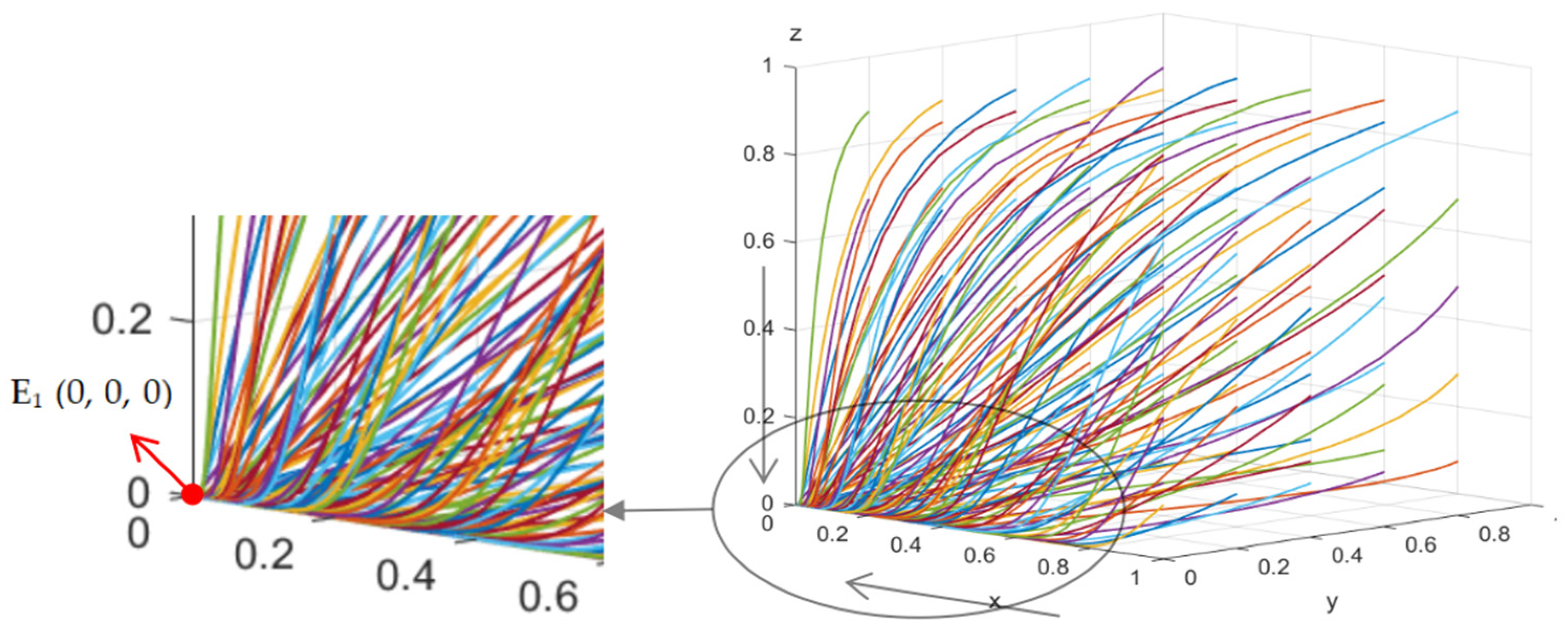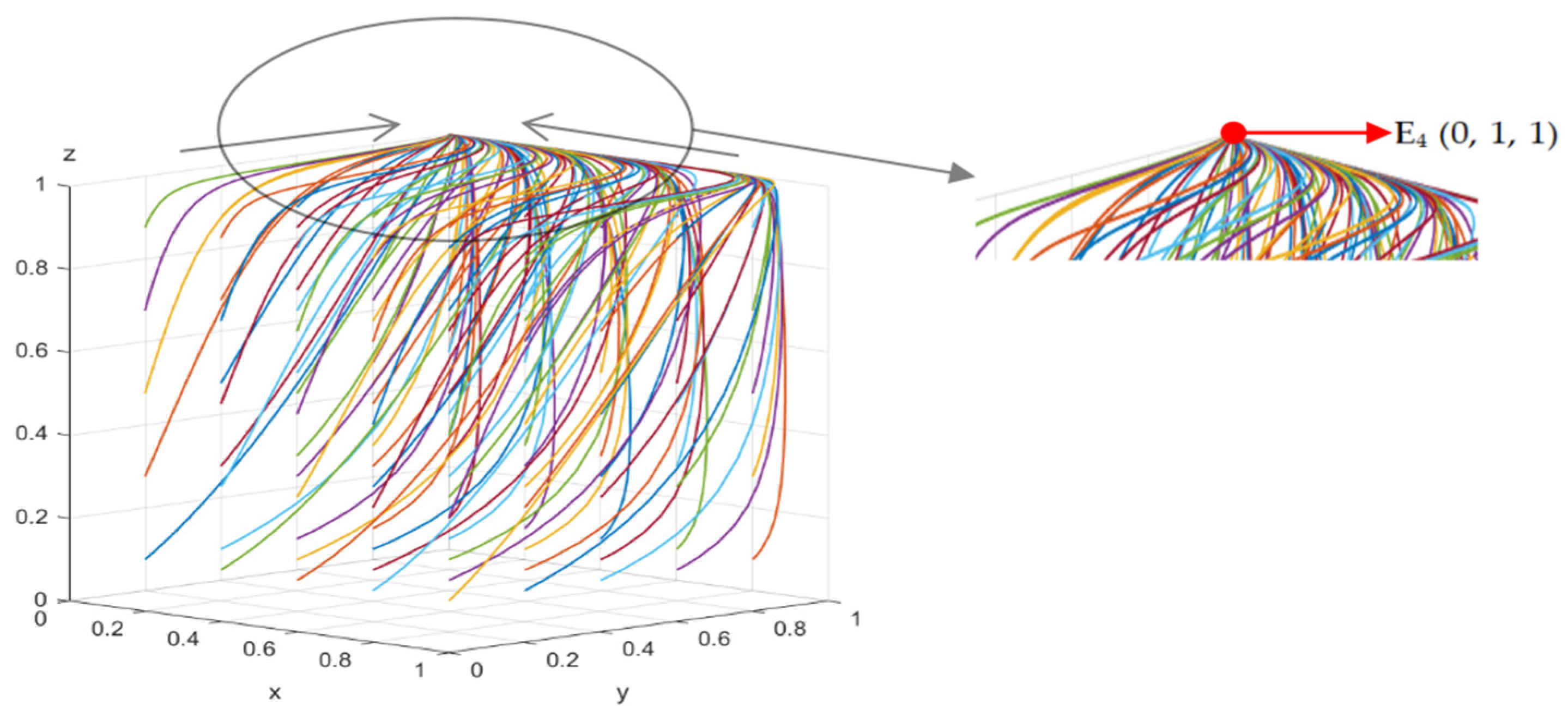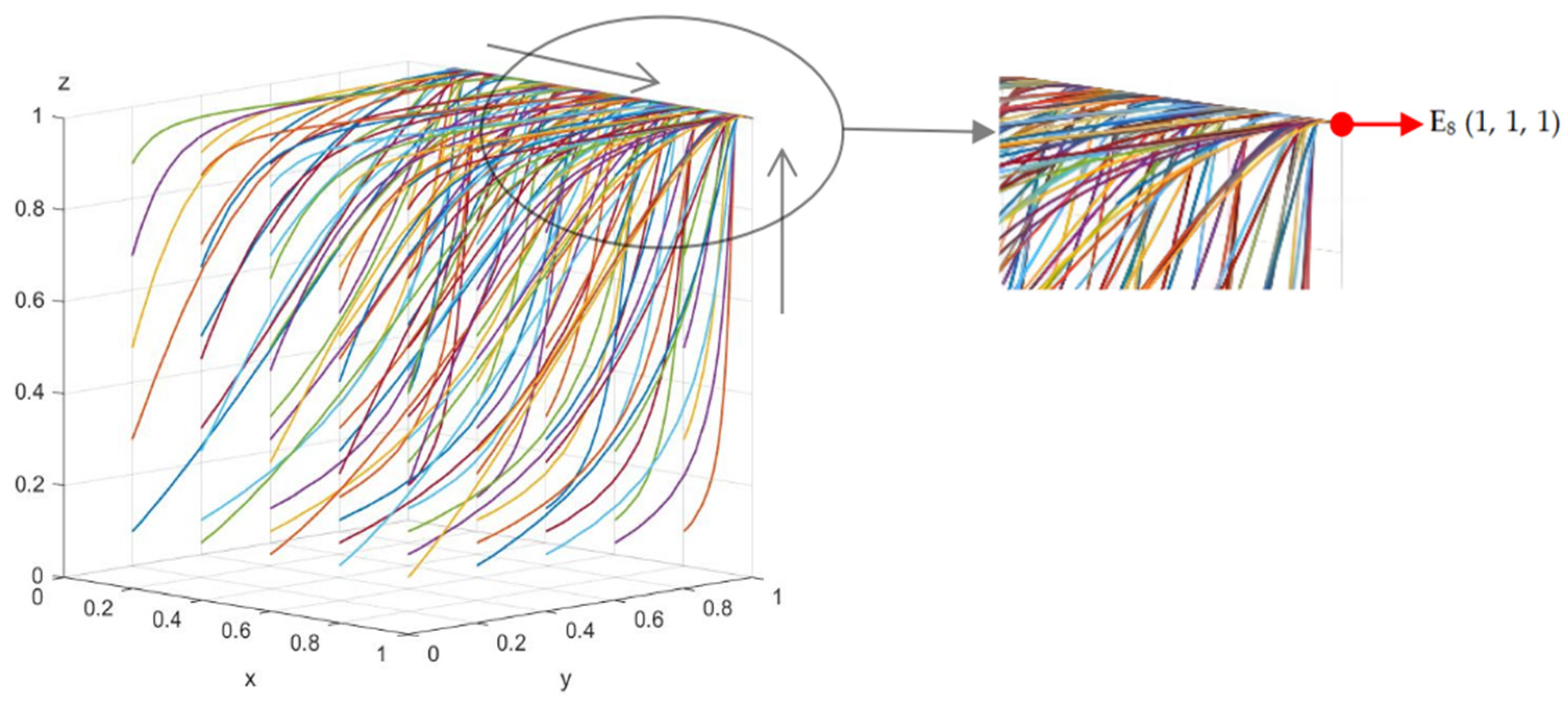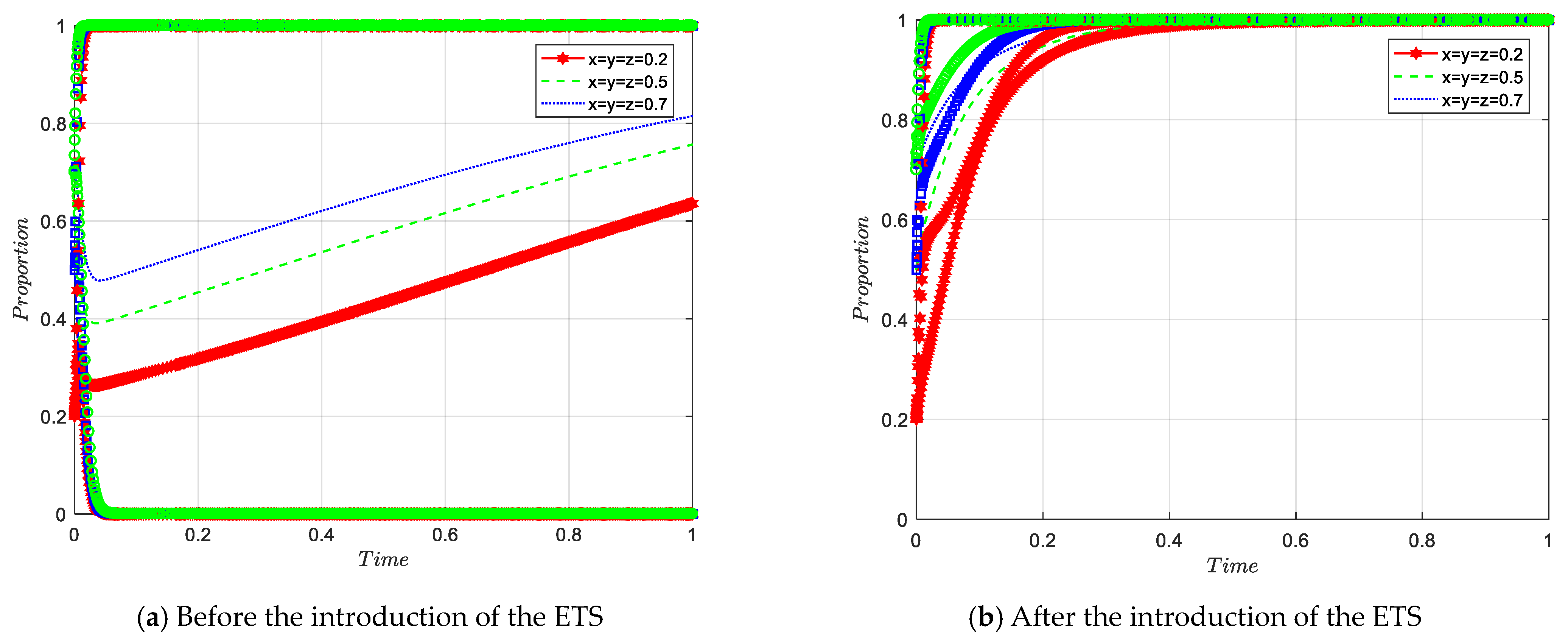Evolutionary Game Analysis of Collaborative Prefabricated Buildings Development Behavior in China under Carbon Emissions Trading Schemes
Abstract
:1. Introduction
- (1)
- We are considering differences in the behavioral choices of developers facing an ETS with different low-carbon and investment levels. Therefore, by using the proportion of low-carbon investment to reflect the low-carbon level and dividing developers into two categories, the natural process of behavioral choices between heterogeneous developers can be better reflected.
- (2)
- By analyzing the stability and rate of evolution of the system and identifying the key factors influencing developers to develop PBs, it provides more flexible decision-making options for developers within the construction industry, as well as a reliable case study for the government to create a more targeted, feasible, and dynamic policy mix of tools. That is also very much in line with sustainable development in the construction industry and has a certain degree of foresight.
- (3)
- The results of this paper, based on numerical analysis, demonstrate to a certain extent the feasibility of an ETS in the field of PBs, which not only enriches the theoretical guidance in the field of PBs but also provides a market-based tool to internalize the environmental benefits of PBs into economic benefits, which provides a new research approach to promote the development of PBs effectively.
2. Literature Review
3. Three-Party Evolutionary Game Model
3.1. Description of Tripartite Behaviors
3.2. Model Assumptions and Parameterization
3.3. Model Payoff Matrix
4. Analysis of Tripartite Evolutionary Model
4.1. Analysis of Three-Party Subject Evolutionary Strategies
4.1.1. Local Government
4.1.2. Developer U
4.1.3. Developer M
4.2. Stability Analysis of the Evolutionary Game Model
5. Numerical Analysis
5.1. Data Source
5.2. Analysis of Tripartite Evolution Results at Different Stages
- (1)
- The initial stage of the three-party evolution results
- (2)
- The three-party evolutionary results of the transition stage
- (3)
- Tripartite evolution results for the growth stage
- (4)
- Three-party evolutionary results in the stabilization stage
5.3. Sensitivity Analysis
- (1)
- The influence of PB gain
- (2)
- Effect of synergy gain
- (3)
- The effect of carbon tax unit price
- (4)
- Effect of subsidies
- (5)
- The effect of the penalty range
- (6)
- The effect of liquidated damages
6. Analysis and Discussion
6.1. Impact Analysis of ETS on Tripartite Strategies
6.2. Analysis of the Impact of Synergistic Cooperation Mechanisms on Tripartite Strategies
6.3. Analysis of the Impact of Critical Factors on the Tripartite Strategy
6.3.1. Market Benefits
6.3.2. Government Policy
6.3.3. Subsidies
6.3.4. Liquidated Damages
6.4. Discuss
7. Summary and Policy Implications
7.1. Summary
7.2. Policy Implications
- (1)
- The government can make use of various official channels to increase the publicity of the theory of sustainable development of buildings, enhance the understanding of the public and other stakeholders in different regions about PBs, and increase the green preference of the society for PBs. It should also focus on the combination of industry, academia, and research to promote the development of digital innovations and low-carbon technologies, to enhance the potential benefits of PBs, and especially to play its role in leading enterprises in the PB industry to encourage more enterprises to participate in the development of PBs.
- (2)
- The government can gradually guide the carbon trading market that matches the construction industry towards maturity according to the economic development of different types of construction markets in other regions and continuously improve the relevant carbon trading policies and carbon financial mechanisms to promote the complementarity of the ETS and PB markets. Meanwhile, at the initial stage of promoting the carbon trading policy, the government can appropriately issue subsidies to encourage the collaboration of developers. Then, as the policy matures and the co-development of enterprises gradually stabilizes, the subsidies can be gradually stopped to reduce the financial pressure on the government and relevant measures can be taken to adjust and stabilize the price of the carbon tax to maintain the market’s stability.
- (3)
- The government can introduce applicable legal provisions and specific utility ranges for different stakeholders in different regions or the same region and provide legal protection for the collaborative cooperation of enterprises upstream and downstream of the PB industry chain to promote the proliferation of different types of PB development technologies by using mature collaborative cooperation mechanisms. It can thus increase the number of enterprises mastering skilled technologies and reduce the occurrence of heterogeneous behaviors as well as enhance the interests of enterprises choosing to develop PBs. In addition, for regions that are lagging in development or are in the growth phase of development, feasible carbon finance mechanisms and matching legal mechanisms can be formulated to enhance the vitality of the carbon and construction markets healthily.
8. Limitations and Future Research
Author Contributions
Funding
Institutional Review Board Statement
Informed Consent Statement
Data Availability Statement
Conflicts of Interest
References
- 2023 China Construction Industry PB Development Research Report. Available online: https://show.precast.com.cn/news/show.php?itemid=12431 (accessed on 6 May 2024).
- Cai, K.; Wang, H.; Wang, J.; Bai, J.; Zuo, J.; Chan, K.; Lai, K.; Song, Q. Mitigating lifecycle GHG emissions of building sector through prefabricated light-steel buildings in comparison with traditional cast-in-place buildings. Resour. Conserv. Recycl. 2023, 194, 107007. [Google Scholar] [CrossRef]
- Zhou, Z.; Syamsunur, D.; Wang, L.; Nugraheni, F. Identification of Impeding Factors in Utilising Prefabrication during Lifecycle of Construction Projects: An Extensive Literature Review. Buildings 2024, 14, 1764. [Google Scholar] [CrossRef]
- Chen, G.; Huang, J.; Wang, J.; Wei, J.; Shou, W.; Cao, Z.; Pan, W.; Zhou, J. Optimal procurement strategy for off-site prefabricated components considering construction schedule and cost. Autom. Constr. 2023, 147, 104726. [Google Scholar] [CrossRef]
- Aghasizadeh, S.; Tabadkani, A.; Hajirasouli, A.; Banihashemi, S. Environmental and economic performance of prefabricated construction: A review. Environ. Impact Assess. Rev. 2022, 97, 106897. [Google Scholar] [CrossRef]
- Du, Q.; Wang, Y.; Pang, Q.; Hao, T.; Zhou, Y. The dynamic analysis on low-carbon building adoption under emission trading scheme. Energy 2023, 263, 125946. [Google Scholar] [CrossRef]
- Liu, Y.; Chang, R.-D.; Zuo, J.; Xiong, F.; Dong, N. What leads to the high capital cost of prefabricated construction in China: Perspectives of stakeholders. Eng. Constr. Archit. Manag. 2022, 30, 805–832. [Google Scholar] [CrossRef]
- Luo, T.; Tan, Y.; Langston, C.; Xue, X. Mapping the knowledge roadmap of low carbon building: A scientometric analysis. Energy Build. 2019, 194, 163–176. [Google Scholar] [CrossRef]
- Zhang, L.; Li, Q.; Zhou, J. Critical factors of low-carbon building development in China’s urban area. J. Clean. Prod. 2017, 142, 3075–3082. [Google Scholar] [CrossRef]
- Wang, Y.; Mauree, D.; Sun, Q.; Lin, H.; Scartezzini, J.L.; Wennersten, R. A review of approaches to low-carbon transition of high-rise residential buildings in China. Renew. Sustain. Energy Rev. 2020, 131, 109990. [Google Scholar] [CrossRef]
- Du, Q.; Pang, Q.; Bao, T.; Guo, X.; Deng, Y. Critical factors influencing carbon emissions of PB supply chains in China. J. Clean. Prod. 2021, 280, 124398. [Google Scholar] [CrossRef]
- Xue, H.; Wu, Z.; Sun, Z.; Jiao, S. Effects of policy on developer’s implementation of off-site construction: The mediating role of the market environment. Energy Policy 2021, 155, 112342. [Google Scholar] [CrossRef]
- Yu, Z.; Sun, J. Green Cooperation Strategy of PB Supply Chain Based on Smart Construction Management Platform. Sustainability 2023, 15, 15882. [Google Scholar] [CrossRef]
- Wang, T.; Foliente, G.; Song, X.; Xue, J.; Fang, D. Implications and future direction of greenhouse gas emission mitigation policies in the building sector of China. Renew. Sustain. Energy Rev. 2014, 31, 520–530. [Google Scholar] [CrossRef]
- Zhang, X.; Xie, J.; Rao, R.; Liang, Y. Policy incentives for the adoption of electric vehicles across countries. Sustainability 2014, 6, 8056–8078. [Google Scholar] [CrossRef]
- Jung, H.; Song, C.K. Effects of emission trading scheme (ETS) on change rate of carbon emission. Sci. Rep. 2023, 13, 912. [Google Scholar] [CrossRef] [PubMed]
- Chen, Y.; Zhang, D.; Guo, K.; Ji, Q. Emission trading schemes and cross-border mergers and acquisitions. J. Environ. Econ. Manag. 2024, 124, 102949. [Google Scholar] [CrossRef]
- Zhu, R.; Wei, Y.; Tan, L. Low-carbon technology adoption and diffusion with heterogeneity in the emissions trading scheme. Appl. Energy 2024, 369, 123537. [Google Scholar] [CrossRef]
- He, Q.; Wang, Z.; Wang, G.; Zuo, J.; Wu, G.; Liu, B. To be green or not to be: How environmental regulations shape contractor greenwashing behaviors in construction projects. Sustain. Cities Soc. 2020, 63, 102462. [Google Scholar] [CrossRef]
- Wang, G.; Chao, Y.; Cao, Y.; Jiang, T.; Han, W.; Chen, Z. A comprehensive review of research works based on evolutionary game theory for sustainable energy development. Energy Rep. 2022, 8, 114–136. [Google Scholar] [CrossRef]
- Pan, X.; Pan, X.; Wu, X.; Jiang, L.; Guo, S.; Feng, X. Research on the heterogeneous impact of carbon emission reduction policy on R&D investment intensity: From the perspective of enterprise’s ownership structure. J. Clean. Prod. 2021, 328, 129532. [Google Scholar] [CrossRef]
- Li, J.; Gao, L.; Tu, J. Evolutionary Game Analysis of Governments’ and Enterprises’ Carbon-Emission Reduction. Sustainability 2024, 16, 4216. [Google Scholar] [CrossRef]
- Wang, J.; Qin, Y.; Zhou, J. Incentive policies for prefabrication implementation of real estate enterprises: An evolutionary game theory-based analysis. Energy Policy 2021, 156, 112434. [Google Scholar] [CrossRef]
- Li, X.-J.; Xie, W.-J.; Xu, L.; Li, L.-L.; Jim, C.Y.; Wei, T.-B. Holistic life-cycle accounting of carbon emissions of PBs using LCA and BIM. Energy Build. 2022, 266, 112136. [Google Scholar] [CrossRef]
- Xu, A.; Zhu, Y.; Wang, Z. Carbon emission evaluation of eight different prefabricated components during the materialization stage. J. Build. Eng. 2024, 89, 109262. [Google Scholar] [CrossRef]
- He, P.; Zhang, S.; Wang, L.; Ning, J. Will environmental taxes help to mitigate climate change? A comparative study based on OECD countries. Econ. Anal. Policy 2023, 78, 1440–1464. [Google Scholar] [CrossRef]
- Du, Q.; Yang, M.; Wang, Y.; Wang, X.; Dong, Y. Dynamic simulation for carbon emission reduction effects of the PB supply chain under environmental policies. Sustain. Cities Soc. 2024, 100, 105027. [Google Scholar] [CrossRef]
- Zhang, X.; Yang, Q.; Song, T.; Xu, Y. Collaborative Pricing of Green Supply Chain of Prefabricated Construction. Sustainability 2024, 16, 5579. [Google Scholar] [CrossRef]
- Popp, D.; Newell, R.G.; Jaffe, A.B. Energy, the Environment, and Technological Change. In Handbook of the Economics of Innovation; Elsevier B.V.: Amsterdam, The Netherlands, 2010; Volume 2, pp. 873–937. [Google Scholar]
- Wei, Y.; Liang, X.; Xu, L.; Kou, G.; Chevallier, J. Trading, storage, or penalty? Uncovering firms’ decision-making behavior in the Shanghai emissions trading scheme: Insights from agent-based modeling. Energy Econ. 2023, 117, 106463. [Google Scholar] [CrossRef]
- Zhang, Y.-J.; Wei, Y.-M. An overview of current research on EU ETS: Evidence from its operating mechanism and economic effect. Appl. Energy 2010, 87, 1804–1814. [Google Scholar] [CrossRef]
- Liu, J.; Li, J. Economic benefit analysis of the carbon potential of construction waste resource management based on a simulation of carbon trading policy. Environ. Sci. Pollut Res. Int. 2023, 30, 85986–86009. [Google Scholar] [CrossRef]
- Du, Q.; Zhu, H.; Huang, Y.; Pang, Q.; Shi, J. Profit allocation of carbon emission reduction in the construction supply chain. Environ. Dev. Sustain. 2024, 26, 20531–20560. [Google Scholar] [CrossRef]
- Liu, P.K.; Peng, H.; Wang, Z.W. Orderly-synergistic development of power generation industry: A China’s case study based on evolutionary game model. Energy 2020, 211, 118632. [Google Scholar]
- Zhang, M.; Li, H.; Song, Y.; Li, C. Study on the heterogeneous government synergistic governance game of haze in China. J. Environ. Manag. 2019, 248, 109318. [Google Scholar] [CrossRef]
- Zhang, Y.J.; Liu, J.Y. Does carbon emissions trading affect the financial performance of high energy-consuming firms in China? Nat. Hazards. 2018, 95, 91–111. [Google Scholar] [CrossRef]
- Zhao, S.; Song, Q.; Liu, L.; Li, J.; Zhao, D. Uncovering the lifecycle carbon emissions and its reduction pathways: A case study of petroleum refining enterprise. Energy Convers. Manag. 2024, 301, 118048. [Google Scholar] [CrossRef]
- Chang, C.-L.; Mai, T.-K.; McAleer, M. Establishing national carbon emission prices for China. Renew. Sustain. Energy Rev. 2019, 106, 1–16. [Google Scholar] [CrossRef]
- Wang, K.; Lu, C. Achievements and Prospects of Carbon Market Construction in China. 2024. Available online: https://ceep.bit.edu.cn//zxcg/ndycbg/8faf214eba0e481aa7af71880c22c7a3.htm (accessed on 7 February 2024).
- Implementation Plan for the Setting and Allocation of Total National Carbon Emission Trading Quotas in 2021 and 2022 (Power Generation Industry). Available online: https://www.gov.cn/zhengce/zhengceku/2023-03/16/content_5747106.htm (accessed on 13 March 2023).
- Shenzhen 2023 Carbon Emission Quota Allocation Plan. Available online: https://meeb.sz.gov.cn/gkmlpt/content/10/10652/post_10652376.html#3767 (accessed on 6 June 2023).
- Liu, D.; Feng, M.; Liu, Y.; Wang, L.; Hu, J.; Wang, G.; Zhang, J. A tripartite evolutionary game study of low-carbon innovation system from the perspective of dynamic subsidies and taxes. J. Environ. Manag. 2024, 356, 120651. [Google Scholar] [CrossRef]
- Song, X.; Lu, Y.; Shen, L.; Shi, X. Will China’s building sector participate in emission trading system? Insights from modelling an owner’s optimal carbon reduction strategies. Energy Policy 2018, 118, 232–244. [Google Scholar] [CrossRef]
- Interpretation of the Supreme People’s Court on Several Issues Concerning the Application of the General Rules of Contract Compilation in the Civil Code of the People’s Republic of China. Available online: https://www.chinacourt.org/article/detail/2023/12/id/7681709.shtml (accessed on 5 November 2023).
- Prefabricated Construction Project Investment Estimation Index. Available online: https://www.gov.cn/zhengce/zhengceku/202308/content_6901196.htm (accessed on 28 July 2023).
- China Statistical Yearbook 2023. Available online: https://www.stats.gov.cn/sj/ndsj/2023/indexch.htm (accessed on 12 November 2023).
- Zhao, T.; Liu, Z. A novel analysis of carbon capture and storage (CCS) technology adoption: An evolutionary game model between stakeholders. Energy 2019, 189, 116352. [Google Scholar] [CrossRef]
- Yuan, M.; Li, Z.; Li, X.; Li, L.; Zhang, S.; Luo, X. How to promote the sustainable development of prefabricated residential buildings in China: A tripartite evolutionary game analysis. J. Clean. Prod. 2022, 349, 131423. [Google Scholar] [CrossRef]
- Wu, Z.; He, Q.; Li, J.; Bi, G.; Antwi-Afari, M.F. Public attitudes and sentiments towards new energy vehicles in China: A text mining approach. Renew. Sustain. Energy Rev. 2023, 178, 113242. [Google Scholar] [CrossRef]
- Song, Y.; Li, C.; Zhou, L.; Huang, X.; Chen, Y.; Zhang, H. Factors affecting green building development atthemunicipal level: A cross-sectional study in China. Energy Build. 2021, 231, 116352. [Google Scholar] [CrossRef]
- Gao, Y.; Tian, X.L. Prefabrication policies and the performance of construction industry in China. J. Clean. Prod. 2022, 253, 120042. [Google Scholar] [CrossRef]
- Wang, Q.-C.; Yu, S.-N.; Chen, Z.-X.; Weng, Y.-W.; Xue, J.; Liu, X. Promoting additive construction in fast-developing areas: An analysis of policies and stakeholder perspectives. Dev. Built Environ. 2023, 16, 100271. [Google Scholar] [CrossRef]
- Li, S.; Wang, Q.-C.; Wei, H.-H.; Chen, J.-H. Extended Reality (XR) Training in the Construction Industry: A Content Review. Buildings 2024, 14, 414. [Google Scholar] [CrossRef]












| Parameters | Descriptions |
|---|---|
| Cga | Costs of positive local government promotion |
| Cgn | Cost of negative promotion by local government |
| S | Subsidies granted by local government |
| Bg | Revenue to the government when developers all choose to proceed with the development of conventional buildings |
| R | Income or loss on local government performance |
| g | The magnitude of additional penalties for developers choosing to develop conventional buildings when actively promoted by the local government |
| L | Free carbon credits allocated by local government |
| Lb | Carbon emissions from developers choosing to collaborate and cooperate in the development of PBs |
| P | Price of carbon tax charged to developers by local government |
| Ci | The initial cost to the developer of developing a conventional building |
| Bi | Initial revenue to the developer when developing a conventional building |
| Ei | Environmental benefits to the government when developers collaborate to develop PBs |
| ΔCi | Additional environmental governance costs to the government when developers develop conventional buildings |
| k | Proportion of developer U’s investment in choosing to collaborate in the development of PBs |
| 1 − k | Proportion of developer M’s investment in choosing to collaborate in the development of PBs |
| Li | Carbon emissions when a developer chooses to develop a conventional building |
| E | Additional environmental benefits to the government if the developer chooses to collaborate on the development of the PB |
| C | The incremental cost to the developer in choosing to engage in PB behavior |
| B | Incremental benefits to the developer of choosing to engage in PB behavior |
| v | Synergistic benefits when developers choose to engage in PB behavior |
| x | The probability that the government chooses to promote the behavioral strategy actively |
| y | The probability that developer U chooses a collaborative and cooperative development behavioral strategy for PBs |
| z | The probability that developer M chooses the strategy of collaborative cooperation in developing PB behavior |
| Local Government (G) | Developer (u) | Developer (m) | |
|---|---|---|---|
| MPS (z) | MNS (1 − z) | ||
| GA (x) | UPS (y) | + (1 − ) | |
| UNS (1 − y) | : : | ||
| GA (1 − x) | UPS (y) | + (1 − | |
| UNS (1 − y) | : : |
| Equilibrium Points | Eigenvalues |
|---|---|
| (0, 0, 0) | |
| (0, 0, 1) | |
| (0, 1, 0) | |
| (0, 1, 1) | |
| (1, 0, 0) | |
| (1, 0, 1) | |
| (1, 1, 0) | |
| (1, 1, 1) |
| Parameters/Stage | Initial Stage | Transformation Stage | Growth Stage | Stabilization Stage |
|---|---|---|---|---|
| 2900 | 2950 | 3100 | 3150 | |
| 40 | 40 | 90 | 90 | |
| 3100 | 3100 | 3100 | 3100 | |
| 3100 | 3100 | 3100 | 3100 | |
| 3300 | 3200 | 3100 | 3000 | |
| 2989 | 2989 | 2989 | 2989 | |
| 2989 | 2989 | 2989 | 2989 | |
| 20 | 30 | 90 | 90 | |
| 20 | 30 | 90 | 90 | |
| 2224 | 2135 | 2050 | 1968 | |
| 2780 | 2700 | 2620 | 2593 | |
| 2780 | 2780 | 2780 | 2780 | |
| 2780 | 2780 | 2780 | 2780 | |
| 180 | 150 | 120 | 120 | |
| 20 | 30 | 30 | 30 | |
| 15 | 15 | 15 | 15 | |
| 50 | 100 | 50 | 50 | |
| 100 | 60 | 30 | 0 | |
| 0.01 | 0.04 | 0.07 | 0.1 | |
| g | 0.1 | 0.2 | 0.3 | 0.4 |
| 20 | 20 | 20 | 20 | |
| 50 | 50 | 50 | 50 | |
| 50 | 50 | 50 | 50 | |
| 25 | 25 | 25 | 25 | |
| 60 | 60 | 60 | 60 | |
| 60 | 60 | 60 | 60 |
Disclaimer/Publisher’s Note: The statements, opinions and data contained in all publications are solely those of the individual author(s) and contributor(s) and not of MDPI and/or the editor(s). MDPI and/or the editor(s) disclaim responsibility for any injury to people or property resulting from any ideas, methods, instructions or products referred to in the content. |
© 2024 by the authors. Licensee MDPI, Basel, Switzerland. This article is an open access article distributed under the terms and conditions of the Creative Commons Attribution (CC BY) license (https://creativecommons.org/licenses/by/4.0/).
Share and Cite
Cao, W.; Sun, Y. Evolutionary Game Analysis of Collaborative Prefabricated Buildings Development Behavior in China under Carbon Emissions Trading Schemes. Sustainability 2024, 16, 8084. https://doi.org/10.3390/su16188084
Cao W, Sun Y. Evolutionary Game Analysis of Collaborative Prefabricated Buildings Development Behavior in China under Carbon Emissions Trading Schemes. Sustainability. 2024; 16(18):8084. https://doi.org/10.3390/su16188084
Chicago/Turabian StyleCao, Wenbin, and Yiming Sun. 2024. "Evolutionary Game Analysis of Collaborative Prefabricated Buildings Development Behavior in China under Carbon Emissions Trading Schemes" Sustainability 16, no. 18: 8084. https://doi.org/10.3390/su16188084




